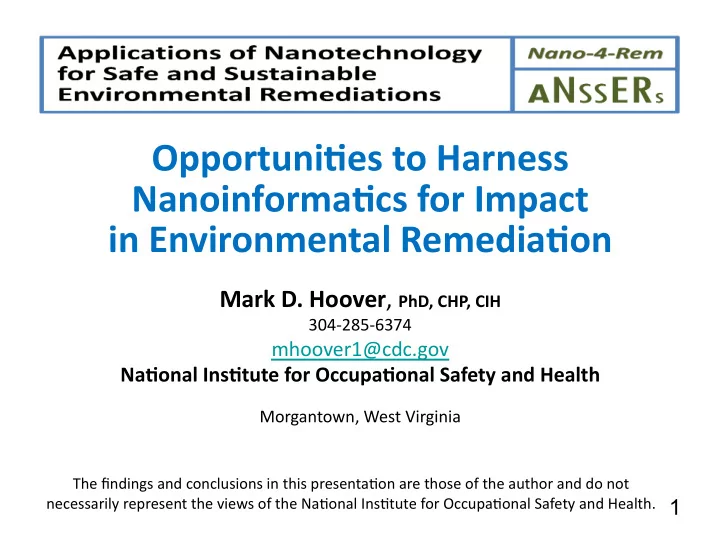

OpportuniHes ¡to Harness ¡ NanoinformaHcs ¡for Impact ¡ in Environmental ¡RemediaHon Mark ¡D. Hoover , PhD, ¡CHP, ¡CIH ¡ 304-‑285-‑6374 mhoover1@cdc.gov NaHonal ¡InsHtute for OccupaHonal ¡Safety ¡and Health Morgantown, West ¡Virginia The findings and conclusions in this presentaCon are those of the author and do not ¡ necessarily represent ¡the views of the NaConal InsCtute for OccupaConal Safety and Health. 1
Our Nano-4-Rem Premise We can identify and address the occupational and non-occupational hazards and opportunities of engineered nanomaterials in environmental remediation through a Knowledge Infrastructure https://nanohub.org/groups/nano4rem Grass ¡roots ¡involvement in our community of pracDce is ¡required! 2
A key community connection You are invited to participate in the community-based Nanoinformatics 2020 Roadmap. www.nanotechinformatics.org 3
A key federal connection www.nano.gov/NKIPortal 4
Our Approach Define Nanoinformatics: Principles and Practices Who we are ... (Leaders, Cultures, Systems) What we are trying to accomplish ... When we are taking acDon ... Where we are involved ¡... Why we taking specific acDons ¡... How we are defining and meeDng our goals ¡... This ¡is ¡a work ¡in progress ¡... 5
A Matrix View of “Who we are” and “What we need” Health ¡and safety ¡ Legal ¡community facility providers Equipment and and regulators Policy makers pracHHoners Emergency ¡ Researchers Responders Consumers Managers Financiers Students ¡ Educators Materials suppliers Workers Insurers Society Media Literacy ¡and CriHcal Thinking Skills Real Life Examples Understanding ¡ (not ¡rote applicaCon) ConHnuous ¡ Improvement Modeling and Sharing Assessment Specific messaging and actions in each element of the matrix must be based on (a) what knowledge and 6 understanding each stakeholder needs and (b) what knowledge and understanding each stakeholder can provide.
A Working Definition of Nanoinformatics • The science and practice of determining which information is relevant to meeting objectives of the nanoscale science and engineering community, • and then developing and implementing effective mechanisms • to collect, validate, store, share, analyze, model, and apply the information, and then to confirm achievement of the intended outcome from use of that information, • and then conveying experience to the broader community, contributing to generalized knowledge, and updating standards and training . Adapted from hJp://www.internano.org/nanoinformaHcs/ 7
A Sensible, Sustainable Life Cycle Set Update Determine Mission Guidance, Relevance/ Standards, Objectives Reliability and Training Goals Contribute Create to Generalized and Knowledge Collect A Life-Cycle Approach Convey Validate Experience for Informatics Documentation and Improvement Store Confirm Effectiveness Analyze Share Apply and Model Each ¡step ¡must ¡be ¡tailored ¡to ¡our ¡mission. ¡ 8
Informatics Roles and Responsibilities 3 2 1 5 6 Customers Creators Curators Analysts 4 EffecHveness Set ¡Mission ¡ and ¡Model Experience ¡ ObjecHves Determine ¡ Generalize ¡ Relevance ¡ Guidance ¡ Analyze ¡ ¡ Validate Confirm ¡ Convey ¡ Update ¡ Collect ¡ Apply ¡ Share ¡ Store Customers X ¡ X ¡ X ¡ X ¡ X ¡ X ¡ X ¡ Creators X ¡ X ¡ X ¡ X ¡ X ¡ Curators X ¡ X ¡ X ¡ X ¡ X ¡ X ¡ Analysts ¡ X ¡ X ¡ X ¡ X ¡ X ¡ X ¡ CommunicaDon ¡and ¡understanding ¡are ¡essenDal ¡at ¡all ¡steps. ¡ 9
INFORMATICS 4 IMPACT A ¡criDcal ¡point ¡of ¡view ¡ I The “ I ”s are in the eye of the beholder. One ¡size ¡does ¡not ¡fit ¡all... ¡ 10
INFORMATICS 4 IMPACT An ¡implementaDon ¡example ¡ • IdenDfy ¡ mission ¡objecCves ¡and ¡informaCon ¡needs ¡ ¡ • IniDate ¡a ¡plan ¡to ¡gather, ¡examine, ¡and ¡evaluate ¡that ¡ informaCon • InvesDgate ¡to ¡detect, ¡collect, ¡and ¡inspect ¡the ¡relevant ¡ informaCon • Incorporate ¡findings ¡and ¡conclusions ¡into ¡everyday ¡ pracCces ¡to ¡beneficially ¡impact ¡workers, ¡consumers, ¡and ¡ communiCes ¡ • Improve ¡ by ¡confirming ¡outcomes ¡ ¡ and ¡making ¡adjustments ¡as ¡needed I One ¡size ¡does ¡not ¡fit ¡all... ¡ The “ I ”s are in the eye of the beholder. 11 We ¡basically ¡need ¡to ¡Plan, ¡Do, ¡Check, ¡Adjust. ¡
Opportunities to Partner ¡ Some Components of the NKI Summer School for Integrated Computational Materials Education OpenKIM The Materials Project Interatomic Potentials Repository Project • Supported by NIH, NIOSH, NIST, NSF, ONR, DOE, EPA … A ¡wide ¡array ¡of ¡nanoinformaDcs ¡acDviDes ¡are ¡already ¡underway. ¡ 12
A Convergence for Information Sharing Safety, Health, * Nanotechnologies Well-being, and Productivity Focus ¡on ¡the ¡ Risk Management Convergence ¡= ¡ ¡ Focus ¡on ¡Success. ¡ 13
Four Steps for Community Action to build and sustain leaders, cultures, and systems for safety, health, well-being, and productivity Engage the community Thank ¡you ¡for ¡partnering ¡with ¡Nano-‑4-‑Rem ¡for ¡impact. ¡ 14
Questions ? Mark D. Hoover, PhD, CHP, CIH Senior Research Scientist Respiratory Health Division and NIOSH Center for Direct Reading and Sensor Technologies National Institute for Occupational Safety and Health Centers for Disease Control and Prevention 1095 Willowdale Road Morgantown, West Virginia 26505-2888 Phone: 304-285-6374 Email: mhoover1@cdc.gov 15
Example ¡iniHaHve ¡for ¡Data ¡Readiness ¡Levels ¡ Concept ¡for ¡Expressing ¡Data ¡Maturity ¡ 16 Readiness ¡level ¡is ¡applicaDon-‑dependent. ¡
Data ¡Readiness ¡Levels ¡ Summary ¡of ¡DRLs ¡Versus ¡Data ¡A[ributes ¡ Data ¡aVribute ¡details ¡are ¡applicaDon-‑dependent. ¡ 17
Recommend
More recommend